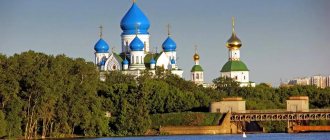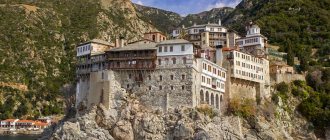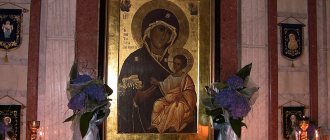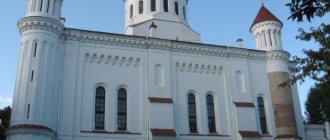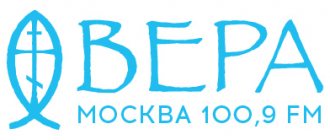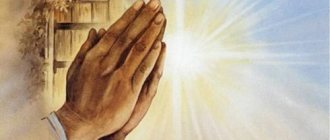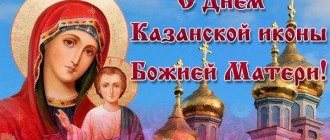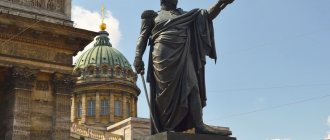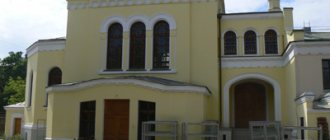The history of the acquisition of the Iveron Icon
The history of this miraculous image of the Queen of Heaven begins in the 9th century. In those days, Emperor Theophilus reigned - a furious persecutor of icons. The Iveron Icon was then in the vicinity of Nicaea, with a pious widow woman who revered it very much and built a special temple for it. When, following a denunciation, soldiers came to take away and destroy the image, the woman paid them and begged them to leave the shrine in her house until the morning. The warriors agreed, but one of them hit the holy image with a sword, and real blood flowed from the resulting wound on the face of the Most Holy One.
At night, the widow, accompanied by her son, took the icon to the seashore and, having prayed, bowed and kissed it, lowered it into the water to protect it from desecration and desecration by persecutors. But she did not drown, but standing vertically walked through the water to the west. The son of that woman hid from persecutors in Greece, settled on Mount Athos and became a monk. From him the inhabitants of the Holy Mountain learned about this miracle.
The history of this miraculous image of the Queen of Heaven begins in the 9th century
Once, after the death of the Iveron monk, the monastics of the Iveron monastery on Athos saw a column of fire on the sea. This phenomenon lasted for three days. The brethren went down to the sea and saw an icon of the Most Holy Theotokos on the water in a pillar of fire. But the closer the fathers came to the water, the further it moved away from them. Elder Gabriel, who was then living on Athos, famous for his piety and purity, comparable to that of an angel, had an apparition of the Most Holy Theotokos, in which she ordered him, walking on the water, to accept Her image, since she wanted to bestow it on them. Everything was fulfilled according to the word of the Mother of God, the elder walked on the water and accepted the icon.
After three days of incessant prayer at the image, it was placed in the altar of the temple, but the next day it was discovered above the gates of the monastery. Repeatedly, the icon itself miraculously moved to the gate, and then it was returned to the temple. As a result, the Mother of God again appeared to Elder Gabriel and ordered him not to tempt Her any more and not to return her image to the altar, since she wanted to protect the brethren herself, and not to be protected. Then, for the miraculous image, a small temple was built above the gates of the monastery, which still exists. Its other name is Portaitissa, or Goalkeeper. In 2019, jewelry and precious donations from people placed near the icon were stolen.
It is known that when the Iveron Icon leaves the Holy Mountain, Athos will plunge into the depths of the sea. The Most Pure One herself told the monks not to be afraid of anything while her icon was above the gates of the monastery, but when it disappeared, then the monks should leave there too.
Due to the massive retreat from Orthodox canons and dogmas among the laity, monasticism and clergy, as well as the adoption of ecumenism even by the patriarchs and inhabitants of Athos, this time is approaching. Through the hands of the clergy they began to confuse Orthodoxy with heretics and pagans under the silence of the flock, although the Mother of God herself called Catholics “...My enemies and the enemies of My Son.” The Most Holy Theotokos, in an appearance to one pious monk, revealed that she was “already at the water.” There is an opinion that the icon has already moved from its place above the gates of the monastery, and in its place there is a copy. On the icon, on the face of the Queen of Heaven, a wound has been preserved - a mark from a blow with a sword.
Holiday traditions
Now let's talk in more detail about the traditions of this day. According to the popular calendar, October 26 is called Bannik or Bath Day. It has come down to us from the times when paganism was the main religion on Russian lands. Then, on the specified date, a traditional bath in the bathhouse should have been organized.
When going to take a steam bath, they were sure to stock up on infusions made from various herbs, which were believed to have healing powers and could even cure epilepsy. People believed that the bannik (that is, the spirit living in the bathhouse) expels their ailments from the sick. But to do this, you need to show respect to him - first of all, when entering the bathhouse, get rid of the cross on your body. And they didn’t forget to ask the bath attendant for permission to go take a steam bath and swim.
People tried to adhere to specific, strict rules, because they believed that if they broke them, they would bring upon themselves many troubles and misfortunes. For example, they didn’t go to the bathhouse at night, believing that then the bathhouse owner himself wanted to swim and they could stop him. The spirit was represented as an incorporeal creature, sometimes turning into a dog, cat, hare or frog. When leaving the bathhouse on October 26, he was left with water and a broom with soap overnight.
Under no circumstances were icons or other Christian attributes brought into the bathhouse. Otherwise, it was possible to anger the bannik, but he would already find a way to take revenge - for example, throw a stone at the offender. And the most useful time spent in the steam room was considered to be when it was the third, fourth or seventh steam.
Since pagan times, the custom of not being alone and in the dark on October 26 has been preserved: since ancient times, people tried to go for a walk on this day, lit fires, and lit candles in their houses - in order to prevent evil spirits (bad spirits) from getting into the home and causing harm.
Interesting! On a holiday, it is not recommended to refuse invitations to visit; be sure to make a guest visit if you are invited.
These were traditions more related to pagans. Let's now talk about Orthodox people. On October 26, they should visit the temple, where the clergy conduct a festive service and read special prayers dedicated to the icon of the Virgin Mary. Believers turn to the Mother of God with requests to protect them from all evil, improve their health, and forgive any sins.
What is unacceptable to do on the day of the celebration of the Iveron Icon of the Mother of God?
- Conflict, argue, use obscene words in speech.
- Refuse to help if you are asked for something.
- Overeat or, even more so, drink a lot of alcoholic beverages.
- Carry out your duties irresponsibly.
- Lies, slander, condemnation or concealment of information are strictly prohibited.
- Envy is another extremely negative feeling in human nature that needs to be gotten rid of. When you see someone else's success, rejoice from the bottom of your heart. And if someone seems to be deliberately provoking you to envy with their boasting, then it is better to minimize contacts with such a person.
- You should not use sharp objects, as there is a high risk of causing injury to yourself. Be very careful with knives, other potentially dangerous tools and fire.
How does the Iveron image of the Mother of God help?
In Rus' this image is especially revered. They pray before him under various everyday needs and circumstances, and ask:
- liberation from life's difficulties;
- consolation in sorrows;
- protection from the elements;
- granting land fertility.
Giving land fertility
Elemental protection
Consolation in sorrows
Everyone who resorts to the Most Holy Theotokos and sincerely prays and repents before Her image receives help and consolation, as from her own mother, because the Mother of God adopted all humanity at the Cross of Her Son.
According to legend, the Iveron Icon was painted by St. Evangelist Luke.
Traditions and rituals for the Iverskaya holiday
— They prayed to the Iveron Icon of the Mother of God for deliverance from various everyday troubles, for consolation in grief. Also in prayers they asked for protection from fire and to increase the fertility of the earth.
— Russian people usually held baths on Iverskaya. The bathhouse was heated hotly, infusions of medicinal herbs were placed on the shelves, and patients with epilepsy were brought into the steam room. They believed that the bath spirit could drive out the disease.
— People believed that the bath spirit is a creature that never shows itself to a person, but can remind of itself by making noise. He drives away visitors who are objectionable to him, he can knock and even throw stones at people. They also believed that the bath spirit could be seen if it turned, for example, into a hare, dog, cat, broom or frog. They called him Bannik and they said that he also loved to swim, usually doing it on the third, fourth, seventh couples, that is, after 2-3 shifts of people who had been to the bathhouse.
“We usually left water, a broom and soap for Bannik at night so that he could steam in peace. The peasants themselves avoided going to the bathhouse at night and after sunset. They never left any icons in the bathhouse, but washed themselves after first removing the pectoral cross. The ancestors tried to enter the bathhouse with caution, and at the entrance they asked permission from Bannik, apologizing for disturbing him: “Mr. owner, let me go into the bathhouse to wash and take a steam bath.”
Days of veneration of the holy image
Celebrations in honor of the miraculous image take place 4 times a year. Holiday dates determined by the church calendar:
- 25 February;
- Tuesday of Holy Week;
- October 26 - in honor of bringing the copy of the image to Moscow in 1648;
- May 6 – second discovery of the icon list in 2012.
Celebrations in honor of the miraculous image take place 4 times a year.
The Iveron image of the Blessed Virgin Mary is known throughout the world. Through him, the Queen of Heaven granted many miracles and healings.
If you find an error, please select a piece of text and press Ctrl+Enter.
Signs October 26
The people came up with their own signs for each specific day, according to which they made unique “predictions” of what awaited them in the near future.
- On the feast of the Iveron Icon of the Mother of God, clouds appear from the south - soon the weather conditions will change for the worse.
- Whoever did not bathe on this day and did not change dirty clothes to clean ones will have worse health and will get sick a lot in winter.
- Suddenly, on the evening of October 26, a rooster crowed - a sign of weather changes.
- If the rooster crows early in the morning, it will soon become warmer.
- Red clouds appear in the sky - it will rain.
- The sun peeks out from behind the clouds - the weather will change.
Finally, watch the video on the topic:
Prayer to the Most Holy Theotokos before Her Iveron Icon
“O Most Holy Virgin, Mother of the Lord, Queen of Heaven and Earth! Look down upon us from Thy holy height to the adoration of our souls, who with faith and love worship Thy most pure image. Behold, immersed in sins and overwhelmed by sorrows, looking at Your image, as if You were alive and living with us, we offer our humble prayers. The imams have no other help, no other intercession, no consolation except You, O Mother, of all those who mourn and are burdened! Help us, the weak, assuage our sorrow, guide us, the erring, on the right path, save the hopeless, grant us the rest of our lives to spend in peace and silence, grant us a Christian death, and at the Last Judgment of Your Son, the merciful Intercessor will appear to us, may we always sing, We magnify and glorify Thee, as the good Intercessor of the Christian race, with all those who have pleased God. Amen".
Mon, 25 Oct 2022 14:59:31 +0300
Golaeva Irina
Iveron Icon of the Mother of God: what helps?
Why do they pray:
- People pray to the icon to heal the sick
- In order to replenish food supplies, increase productivity
- To get rid of enemy attacks and barbarian raids
- People turn to the image if they need consolation in troubles.
- From disasters and fires
- If you want the land to become fertile
- In case of intrigues, various misfortunes, from evil spirits
- For marriage and women's happiness
- For children's health
It is advisable to pray in front of the icon of the Mother of God in order to heal ailments of the body, as well as the soul. It is necessary to pray not only with repentance, but also with gratitude. Below are several prayers that are said before the face of the Iveron Icon of the Mother of God. Now you can purchase an image of the Iveron Mother of God in any church. She is the intercessor of women and homemakers. Usually this image is hung above the front door. Because she is considered a Goalkeeper. The number of icons that are at home, as well as their placement, is not particularly important.
You can pray in front of the icon of the Iveron Mother of God by saying the prayers listed below in the pictures or in your own words, turning your request to the Saint.
- Prayers are read in front of this icon in any life situations.
Important : However, one should not forget about serving God, because all events with a person happen according to the Will of God.
Prayer of the Iveron Icon of the Mother of God for peace of mind from sudden death, troubles and misfortunes, sorrow, illness and evil.
There are no ready-made prayers for marriage and women's happiness. Speak your requests in your own words, as your soul dictates.
What is the danger of venerating icons?
There are many feasts of the Mother of God icons; about 30 famous icons are celebrated, not to mention lesser-known ones.
“Such a proliferation of revered icons is a sign of a lack of spiritual enlightenment, primarily in the form of conversations, lively answers to people’s questions, and oral instruction,” says the SFI professor.
In the patristic tradition, all this is called catechesis, or catechism. And since now there is no publicity or education, the common people gravitate towards an image that, as if without words, explains everything or, at least, makes it possible to become familiar with something on top of external knowledge.
So the celebration of icons is, of course, a folk tradition that was born in the church by itself: such and such an icon appeared - it is revered, and a holiday is given to it in the year, services are written to this icon. “But this also has its disadvantages,” says Professor Kopirovsky. – Because everything seems very simple and understandable, as if you don’t need to know or understand anything else. Historically, this “simplicity” turned out to be worse than theft; it covered up the other side of tradition – the spiritual.”
As Kopirovsky says, when the Mother of God icons are celebrated, they talk less and less about the Mother of God, and more about the icon, about the history or legend of its appearance and the miracles associated with it, which seem to live on their own, without connection with Christ. This risks turning into worship of the icon as a thing, and not of the person depicted on it. While the most important thing, the internal meaning of the icon is the appearance of the Mother of God and Christ herself.

